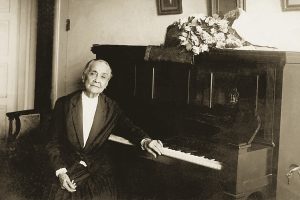By Lizoel Costa
Brazilian Popular Music—known worldwide as MPB (Música Popular Brasileira) – has roots that trace back to the late 19th and early 20th centuries. Its earliest foundations were laid by pioneers such as Chiquinha Gonzaga, whose lively musical gatherings blended Portugal’s sentimental modinha with the rhythmic African lundu. This fusion shook the refined dance salons of the time with a new sensuality and syncopation born from Brazil’s African-descendant communities.
The First Samba and a New Musical Identity
In 1917, Ismael Silva helped ignite a cultural revolution with the arrangement of “Pelo Telefone,” considered the first recorded samba. Written by Donga and Mauro de Almeida, and sung by Bahiano, the song introduced a rhythmic pattern far more Brazilian than the earlier European – African hybrid. Much like the African American blues, early Brazilian chants carried the emotional weight and repression of a people denied their drums and spiritual expression under Christian colonial rule.
Over time, the musical traditions of enslaved Africans in Brazil gained a cautious acceptance from Catholic priests, who tolerated Afro-Brazilian religious practices within the senzalas (slave quarters). This unique religious and cultural syncretism left a permanent imprint on Brazilian music, giving it an identity found nowhere else in the world.
From Samba Masters to the Golden Age of Radio
Throughout the 20th century, Brazilian music continued on an unstoppable path of innovation. Legendary figures such as Sinhô, Pixinguinha, Noel Rosa, Assis Valente, Ary Barroso, and charismatic performers like Mário Reis and Orlando Silva, set the foundations for what would become MPB’s Golden Age.
The 1950s marked the Golden Age of Radio, a period of mass cultural influence that paved the way for a new movement: Bossa Nova. Although João Gilberto rejected the hybrid label of “samba-jazz,” his minimalistic guitar rhythm and intimate singing style redefined Brazilian music forever.
Parallel to this, Carmen Miranda – in her colorful, folkloric Hollywood persona – introduced Brazil to the world, though often in a stylized form. Still, it was Bossa Nova that finally earned Brazilian music widespread international respect. Ambassadors like Tom Jobim, Vinicius de Moraes, Johnny Alf, Carlos Lyra, and Roberto Menescal gave the world a sophisticated new musical language, often intertwined with jazz harmony.
Tropicalia and the Cultural Earthquake of the 1960s
With the “guitar and a stool” era established, the next generation drew from Bossa Nova’s innovations during the televised music festivals of the 1960s – not festivals in the Woodstock sense, but fierce musical competitions. The Tropicália movement took shape, blending electric guitars, psychedelic elements, and Brazilian rhythms. For conservatives, this was sacrilege; for artists like Caetano Veloso and Gilberto Gil, it was liberation.
Music as Resistance (1970s)
During Brazil’s military dictatorship, MPB became a vehicle of resistance. Icons like Chico Buarque, Elis Regina, Maria Bethânia, Gonzaguinha, and the Clube da Esquina collective led by Milton Nascimento, used music as coded political expression and cultural preservation.
The 1980s: A New Wave and the Rise of Brazilian Rock
With democracy returning, the 1980s brought experimentation and the avant-garde movement known as Vanguarda Paulistana. At the same time, Brazilian rock evolved: groups like Titãs, Paralamas do Sucesso, Ira! and Legião Urbana began shedding British and American influences, forging a uniquely Brazilian rock identity.
The 1990s and the Digital Frontier
The 1990s marked Brazil’s reconnection to its musical roots just as the Internet disrupted the traditional recording industry. For the first time, major labels no longer controlled what the public could hear. Brazilian rock, pop and MPB once again embraced samba rhythms and regional grooves, integrating electronic music, hip hop beats, and new global influences.
A New Millennium, Endless Possibilities
Today’s Brazilian music landscape is fluid, eclectic and hard to categorize. Genres overlap and influence each other: samba meets electronic beats, rock blends with Afro-Brazilian percussion, and indie artists draw from the entire 20th-century archive with complete creative freedom.
We may be in a “blurred” moment, as the author writes – but it is the stillness before another Brazilian musical revolution. If history teaches us anything, it’s that Brazil always reinvents itself musically. And the next transformation is already brewing.
* Lizoel Costa is a journalist and musician. He was a member of the Brazilian group “Língua de Trapo” in Rio de Janeiro. He currently lives in Campo Grande, Mato Grosso, where he hosts the radio show “Na Cadeira do DJ” on Regional Radio FM. Contact: lizoelcosta_terra.com.br
FAQ – Frequenly Asked Questions
What is MPB and why is it important?
MPB (Música Popular Brasileira) is a broad term for Brazilian popular music that blends samba, bossa nova, regional rhythms, rock, jazz and folk elements. It represents Brazil’s cultural identity and constant musical innovation.
Bands like Titãs and Legião Urbana shaped a distinct Brazilian rock identity.Bands like Titãs and Legião Urbana shaped a distinct Brazilian rock identity.
What was the first recorded samba?
“Pelo Telefone,” recorded in 1917 and arranged by Ismael Silva, is considered the first official samba recording.
How did Bossa Nova change Brazilian music?
Bossa Nova introduced a sophisticated, jazz-influenced approach to harmony and rhythm, transforming Brazilian music’s global reputation and establishing artists like João Gilberto and Tom Jobim internationally.
What is the Tropicália movement?
Tropicália was a late-1960s cultural movement blending Brazilian rhythms with electric guitars, psychedelia, poetry and political commentary. It reshaped MPB and launched careers of Gilberto Gil and Caetano Veloso.
How has Brazilian music evolved in the 21st century?
Modern Brazilian music blends traditional styles (samba, forró, MPB) with electronic music, hip hop, indie rock and global pop trends. The digital era also democratized music production and distribution.

